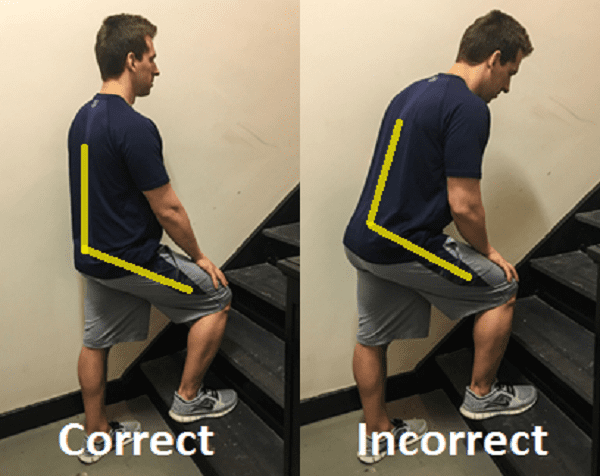How to Negotiate Stairs Without Pain
As a physical therapist, patients frequently tell me, “I have no trouble walking, but climbing the stairs makes me cringe every time.” This comes as no surprise. Stair negotiation increases pressure in the knee by three and a half times your body weight when compared to walking (1). What if I told you there is a proper way to negotiate stairs that protects our joints by taking advantage of stronger leg muscles?
The Golden Rule
The golden rule for stair negotiation is “up with the good and down with the bad.” This means that when ascending stairs, lead with your “good” or stronger leg. When descending stairs, lead with your “bad” or weaker leg. An easy way to remember the golden rule is the good go up to heaven and the bad go down to… you get the idea. This pattern protects our weaker and painful leg, while placing our stronger leg in a position to handle the stresses of stair negotiation.
Posture
I know what you are thinking.. “How does my posture effect me while climbing the stairs?” One common mistake people make when ascending stairs is flexing their spine forward. This forward posture turns stair negotiation into a knee dominant movement. Relative to the hip, the knee is a smaller and weaker joint.
By maintaining an upright posture, stair negotiation becomes a hip dominant movement. Engaging our hip helps to bear weight through two joints; allowing us to use our stronger hips muscles as the primary movers during stair negotiation. Another trick to engage your hip muscles is to place your whole foot on the step and push through your heel.

Fall Prevention
Proper posture will also lead to improved safety while on the stairs. Leaning forward only increases your risk for a fall, as it changes your center of balance toward the ground. Stair falls account for more than 10% of fatal fall accidents (2). Hand rails and the use of an assistive device can be very helpful. Use both handrails when possible. Even using one handrail has been found to reduce the risk of falls on stairs (3).
If you’re using a cane, keep the cane in the hand opposite of the hand rail. The proper way to walk up stairs with a cane involves using the stronger leg first, followed by the cane, and the weaker leg last. When descending the stairs, lead with the cane, followed by the weaker leg, and then come down with the stronger leg. If handrails are unavailable, a cane or crutch is an excellent substitute.
Lastly, be patient. Taking one step at a time is slower, but this “step to” pattern is safer and useful for someone struggling with stairs. Working to strengthen your legs through simple exercises first, such as bridges can allow a transition to more challenging exercises such as squats and mini step ups. Improving the strength of your legs will allow your body to handle the reciprocal stair pattern that we all want.
References
- Kutzner, I., et al. “Loading of the knee joint during activities of daily living measured in vivo in five subjects.” Journal of biomechanics 43.11 (2010): 2164-2173.
- Startzell, Jill K., et al. “Stair negotiation in older people: a review.” Journal of the American Geriatrics Society 48.5 (2000): 567-580.
- Reeves, Neil D., et al. “Influence of light handrail use on the biomechanics of stair negotiation in old age.” Gait & posture 28.2 (2008): 327-336.
Want to feel and move your best?
Treatment is covered by insurance, no referral is needed to start, and with flexible virtual and in-clinic appointments available, you can find a time that works with your schedule.
Click the button below to get started.
